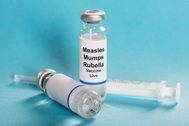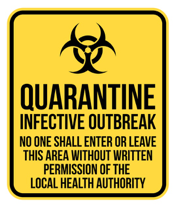- Despite an Effective Vaccine, Measles Outbreaks Continue
- Genotyping by RT-qPCR Has Been Established by the CDC and WHO
- Improved Genotyping by Whole Genome Sequencing Looks Promising
 According to weekly updated data from the Centers for Disease Control and Prevention (CDC), the U.S. is currently experiencing the greatest number of measles cases reported since 1994. From January 1 to May 10, 2019, 839 individual cases of measles have been confirmed in 23 states. In some European countries and other parts of the world, the outbreak numbers are much greater. More than 100,000 people across Europe have been infected with the potentially deadly measles virus, which is spreading an ‘alarming’ rate, according to a recently reported statement by the World Health Organization (WHO). The WHO has said the rise in cases is ‘unprecedented’ for a preventable disease, and the United Nations children’s fund released a report revealing that every year for the last eight years, more than 20 million children have missed their measles vaccine.
According to weekly updated data from the Centers for Disease Control and Prevention (CDC), the U.S. is currently experiencing the greatest number of measles cases reported since 1994. From January 1 to May 10, 2019, 839 individual cases of measles have been confirmed in 23 states. In some European countries and other parts of the world, the outbreak numbers are much greater. More than 100,000 people across Europe have been infected with the potentially deadly measles virus, which is spreading an ‘alarming’ rate, according to a recently reported statement by the World Health Organization (WHO). The WHO has said the rise in cases is ‘unprecedented’ for a preventable disease, and the United Nations children’s fund released a report revealing that every year for the last eight years, more than 20 million children have missed their measles vaccine.
 Despite the ready availability of an effective vaccine, there are two major contributing factors to the occurrence of the current 2019 outbreak in the U.S. The first is misinformation about the safety of this vaccine, which is actually a “trivalent” formulation that provides protection against measles, mumps, and rubella (MMR vaccine) in a single injection. Because of misinformation, some parents are choosing to not have their children vaccinated, representing a group referred to as anti-vaxxers. In January, 2019, the WHO warned that “anti-vaxxers are now one of the greatest threats to world health.” Misinformation persists despite the widespread availability—online and otherwise—of reliable, factual information from the CDC and the WHO.
Despite the ready availability of an effective vaccine, there are two major contributing factors to the occurrence of the current 2019 outbreak in the U.S. The first is misinformation about the safety of this vaccine, which is actually a “trivalent” formulation that provides protection against measles, mumps, and rubella (MMR vaccine) in a single injection. Because of misinformation, some parents are choosing to not have their children vaccinated, representing a group referred to as anti-vaxxers. In January, 2019, the WHO warned that “anti-vaxxers are now one of the greatest threats to world health.” Misinformation persists despite the widespread availability—online and otherwise—of reliable, factual information from the CDC and the WHO.
 The second factor is increased population mobility. In a society that travels for family reasons, business, pleasure, immigration, etc., the probability of contact with infected persons rises significantly. In any case, the increase in outbreaks in the U.S. is undeniable, and there are almost daily news reports on the quarantines that are imposed to prevent further spreading of this highly contagious disease. For example, this past April more than 900 students and staff members at two Los Angeles universities were quarantined or sent home, and in May, the Caribbean nation of St. Lucia quarantined a visiting U.S. cruise ship, barring any passengers or crew from leaving the boat while in port.
The second factor is increased population mobility. In a society that travels for family reasons, business, pleasure, immigration, etc., the probability of contact with infected persons rises significantly. In any case, the increase in outbreaks in the U.S. is undeniable, and there are almost daily news reports on the quarantines that are imposed to prevent further spreading of this highly contagious disease. For example, this past April more than 900 students and staff members at two Los Angeles universities were quarantined or sent home, and in May, the Caribbean nation of St. Lucia quarantined a visiting U.S. cruise ship, barring any passengers or crew from leaving the boat while in port.
As indicated by the title of this blog, I will focus on the molecular aspects of measles virus, rather than further commenting on efficacy, safety, anti-vaxxers, or how nations, states, or cities are attempting to cope with suppressing the spread of measles. Particular attention will be given to nucleic acids-based molecular methods that include virus identification by qPCR or sequencing. However, before getting to those topics, the next section provides some introductory information about measles.
About Measles
The CDC website for measles is a trove of reliable information, and is well worth checking out, as only some selected information is provided here. Historically, measles became a nationally notifiable disease in the United States in 1912, requiring U.S. healthcare providers and laboratories to report all diagnosed cases. In the first decade of reporting, an average of 6,000 measles-related deaths were reported each year. In the decade before 1963 (the year in which a vaccine became available), nearly all children got measles by the time they were 15 years of age. Each year then, among reported cases, an estimated 400 to 500 people died, 48,000 were hospitalized, and 1,000 suffered encephalitis (swelling of the brain) from measles. Symptoms of measles include a characteristic measles rash, as shown here.
In 1954, John F. Enders and Dr. Thomas C. Peebles isolated measles virus from the blood of 13-year-old David Edmonston. Nine years later, in 1963, John Enders and colleagues transformed this Edmonston-B strain of measles virus into a vaccine and licensed it in the U.S. In 1968, an improved measles vaccine developed by Maurice Hilleman and colleagues began to be distributed. This latter vaccine, called the Edmonston-Enders strain, has been the only measles vaccine used in the U.S. since then, and is administered as either trivalent MMR (see above) or tetravalent (MMR and varicella virus/chicken pox, MMRV) formulations.

Genetic Analysis of Measles Viruses

This transmission electron micrograph (TEM) by the CDC/ Brian W.J. Mahy revealed the ultrastructural appearance of a virus particle, or 'virion', of the measles virus. Taken from publicdomainfiles.com and free to use.
The 450 nucleotides (nt) encoding the 150 carboxyl-terminal amino acids of the nucleoprotein have up to 12% nt variation between genotypes, and this entire 450-nt sequence is required for determination of the genotype. Measles virus genotyping can play an important role in tracking transmission pathways during outbreak investigations. Genotyping results can help confirm, disprove, or detect connections among cases. If two cases have matching 450-nt sequences, they are likely connected even if the connection is not obvious.
Measles virus genotyping can help establish which foreign country may be the source of an imported U.S. case, since different genotypes circulate in different countries. However, genotyping alone is not sufficient, since each genotype can circulate in multiple countries and even in different regions of the world. Genotype data is therefore reviewed in conjunction with epidemiological information, such as travel and exposure histories, to determine which country may be the source of an imported US case.
Detection: The detection of measles RNA in a clinical sample can provide laboratory confirmation of infection. Real-time quantitative PCR (RT-qPCR) to detect measles RNA and endpoint RT-PCR to determine the genotype are performed at the CDC. These laboratory protocols are available upon request from the CDC. The RT-qPCR analysis, such as that pictured here, is more sensitive than the endpoint RT-PCR assay for detection of measles RNA in clinical samples, while the endpoint assay is routinely used to amplify the region of the measles genome required to determine the genotype.
RT-qPCR data for SYBR Green fluorescence analysis of five samples, each having three replicates. Taken from commons.wikimedia.org and free to use.
To research this topic further, I used Google Scholar to find publications that covered “RT-qPCR (AND) measles” anywhere in the article. This gave more than 1,100 items, including a collaborative report by the CDC and the WHO titled Improving molecular tools for global surveillance of measles virus. The stated objectives of this study included the development of improved primers and controls for the RT-qPCR reactions used for genotyping of measles samples. The investigators found a new primer pair that was able to amplify the 450-nt sequence from measles viruses. These viruses represented 10 currently circulating genotypes, as well as a genotype A vaccine strain, and demonstrated 100-fold increased sensitivity compared to the previously used primer pair. A nested PCR assay further increased the sensitivity of detection from patient samples.
It is worth interjecting here that improved PCR specificity and sensitivity of primer pairs can be obtained by using TriLink CleanAmp® PCR Products, which achieve “hot start” PCR conditions, thus avoiding the need to design and test different primer sequences or use nested primer pairs. Simply swap out the standard dNTPs or primers in your PCR assay for the corresponding CleanAmp® dNTP Mix or CleanAmp® Primers, respectively. Representative results, publications, and testimonials can be accessed at this link.
Genome Sequencing of Measles Viruses
The 15,894-nt measles virus genome shown here schematically encodes six structural proteins: the nucleoprotein (N), phosphoprotein (P), matrix (M), fusion (F), hemagglutinin (H), and large polymerase (L) proteins. There are also two non-structural C and V proteins, which are both sub-products of the P gene: C results from an overlapping reading frame, and V from an edited transcript. Each coding region is preceded and followed by untranslated regions, of which the longest (1,012 nt) is the non-coding region between the genes for the M and F proteins (M/F NCR).
Schematic representation of the measles virus genome. The 15,894 nucleotides (nt) of the measles virus genome encode: nucleoprotein (N; 525 aa), phosphoprotein (P; 507 aa), matrix (M; 335 aa), fusion (F; 550 aa), hemagglutinin (H; 617 aa), large polymerase (L; 2,183 aa), C (299 aa) and V (186 aa) proteins. Coding regions of the genome (in white) are separated by non-coding regions (NCR; in grey). The longest NCR is that between the M and F genes: M/F NCR (1,012 nt). Amino acids = aa. Taken with permission from ©Penedos et al. PLoS One (2015) 10(11): e0143081.This is an appropriately credited open access article distributed under the terms of the Creative Commons Attribution License, which permits unrestricted use, distribution, and reproduction in any medium.
Penedos et al. state that, due to vaccination, the genomic diversity in circulating measles virus is decreasing. This means that the information provided by the 450-nt (aka N-450) genotyping “window” (see above) is increasingly proving insufficient in the description of outbreaks, as often little or no variation in the sequence is detected. To demonstrate interruption of measles circulation, countries must be able to distinguish between endemic transmission and importation events. The widening of the sequencing window for measles virus may then be necessary to verify measles elimination.

Illumina MiSeq instrument. Taken from Flickr and free to use.
Due to the technical complexity of the bioinformatic methods used for the NGS data processing, phylogenetic analysis, and epidemiological clustering, only the summary conclusions reported by Penedos et al. are given here:
- Analysis of 32 whole genomes obtained from the outbreak indicates that the single nucleotide difference found between the two major groups of N-450 sequences detected during the outbreak is most likely a result of stochastic viral mutation during endemic transmission rather than of multiple importation events.
- Phylogenetic analysis of each genomic region for the strains in this study suggests that most information is acquired from the non-coding region located between the matrix and fusion protein genes (M/F NCR) and the N-450 genotyping sequence.
- Penedos et al. suggested that both M/F NCR and WGS could be used to complement the information from classical epidemiology and N-450 sequencing to address specific questions in the context of measles elimination.
Real-time Measles Species Identification by Nanopore Sequencing

Nanopore-based sequencing, which I have previously blogged about in various contexts, is now being used for real-time identification of various pathogens by virtue of its enablement of sequencing-by-scanning very long, single-molecules of DNA at very high speeds, as detailed elsewhere and depicted here in simplified cartoon form. Nanopore sequencing data starts to stream immediately, rather than being delivered in bulk at the end of a 'run'. This enables an experiment to be stopped as soon as sufficient data has been gathered to answer the question being asked. It can also enable real-time selective sequencing, known as 'Read until...’.
I researched the literature to determine if real-time nanopore sequencing of measles virus has been reported, and was delighted to find that it has! Juul et al. have published a proof-of-concept investigation of a laboratory and analysis workflow in which, starting with an unprocessed (i.e. unenriched or unfractionated) sample, sequence data is generated and bacteria, fungi, and viruses present in the sample are classified to subspecies and strain-level in a quantitative manner. All of this is done without prior knowledge of the sample composition, and in only approximately 3.5 hours, which is quite remarkable to me. This workflow relies on the combination of the Oxford Nanopore Technologies’ MinION™ sequencing device and a real-time species identification bioinformatics software.
It is important to emphasize that, unlike the methodology described in the previous section, this real-time pathogen classification does not use any pathogen-specific primers to selectively amplify one or more pathogens of interest for subsequent ensemble sequencing. Readers interested in the details can consult Juul et al. In a nutshell, they used authentic samples of a relatively large number of representative bacteria, fungi, and viruses—including measles virus, strain Edmonston—to prepare fragmented genomic DNA (for bacteria and fungi) and cDNA (for viruses). These fragments were converted into MinION™ sequencing libraries and sequenced for bioinformatics analysis. The analysis provided an easy to interpret summary report of the pathogens identified and their relative abundance, which was confirmed by RT-qPCR.
Concluding Comments
After reading published literature on nucleic acids-based molecular aspects of measles virus, from which I selected the above topics, I now have mixed feelings. On the positive side, there are safe and effective vaccines (MMR or MMRV) to provide protection against measles, and there are a variety of state-of-the-art PCR and sequencing methods to identify measles viruses for various scientific and health-related purposes. On the negative side, there is continued difficulty in getting high enough vaccination coverage in countries around the world to prevent breakouts, if not eradicate measles. How that problem may be solved is not obvious to me. Put another way, if you will, advances in the science of measles have been relatively straightforward, but widespread acceptance by global societies continues to be elusive.
As usual, your comments are welcomes.
Addendum
After writing this blog, a risk-based assessment study was published in The Lancet Infectious Diseases that provides a list of 25 counties in the U.S. where the next big measles outbreak is most likely to happen.
Also, Larson and Schulz published and editorial in Science magazine titled Reverse global vaccine dissent. They briefly outline the history of vaccine dissent (i.e. anti-vaxxers), they state that, “[t>
o mitigate the globalization of vaccine dissent, while respecting legitimate sharing of concerns and genuine questions, a mix of relevant expertise is needed. Technology experts, social scientists, vaccine and public health experts, and ethicists must convene and take a hard look at the different roles each group has in addressing this challenge. It needs everyone's attention.”









